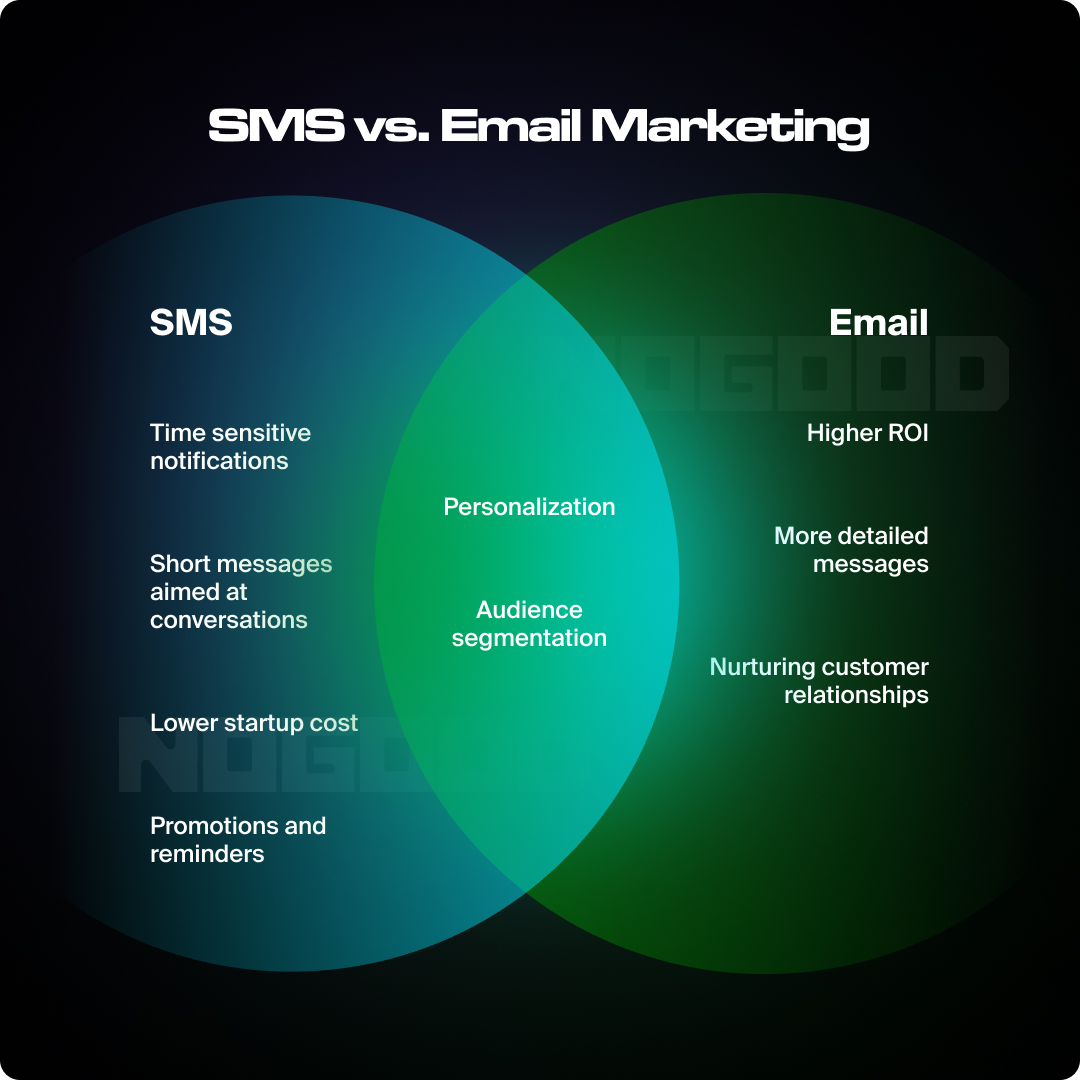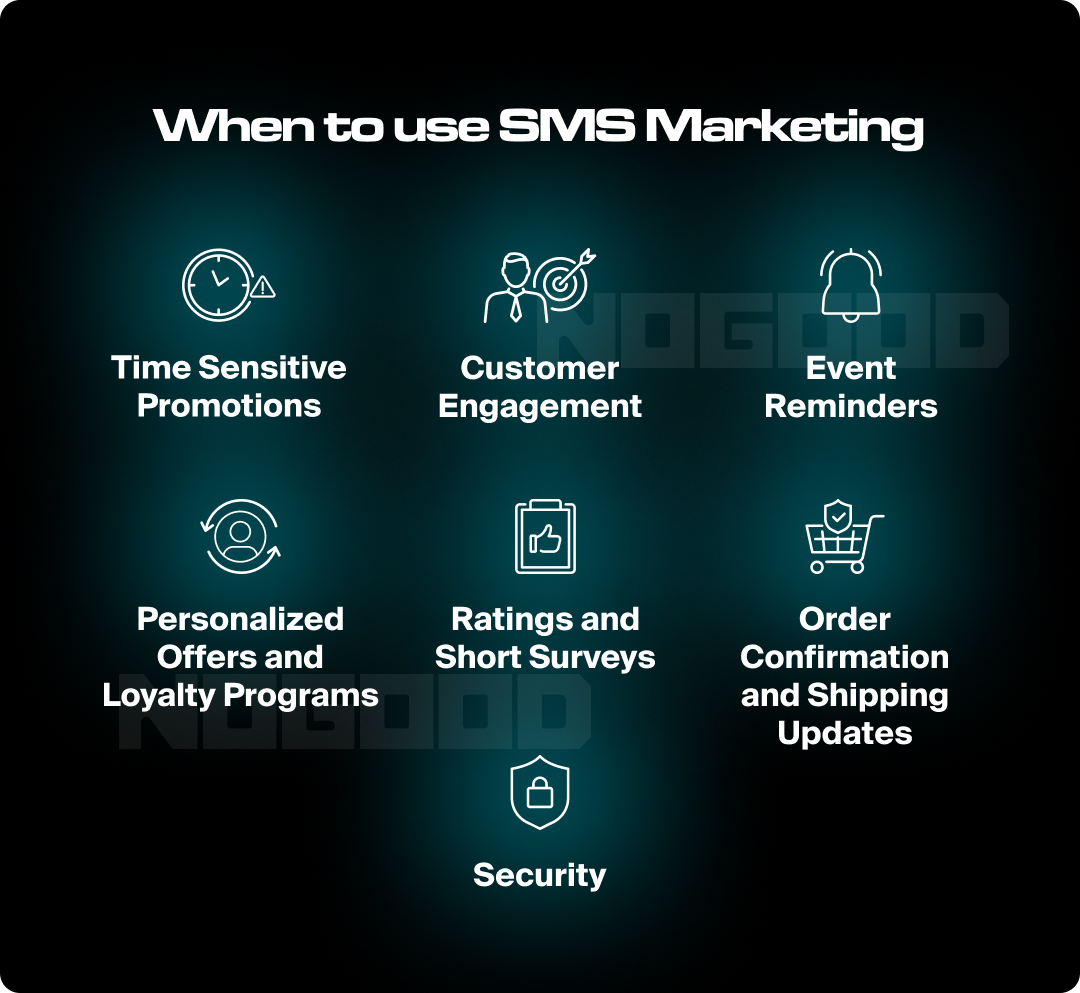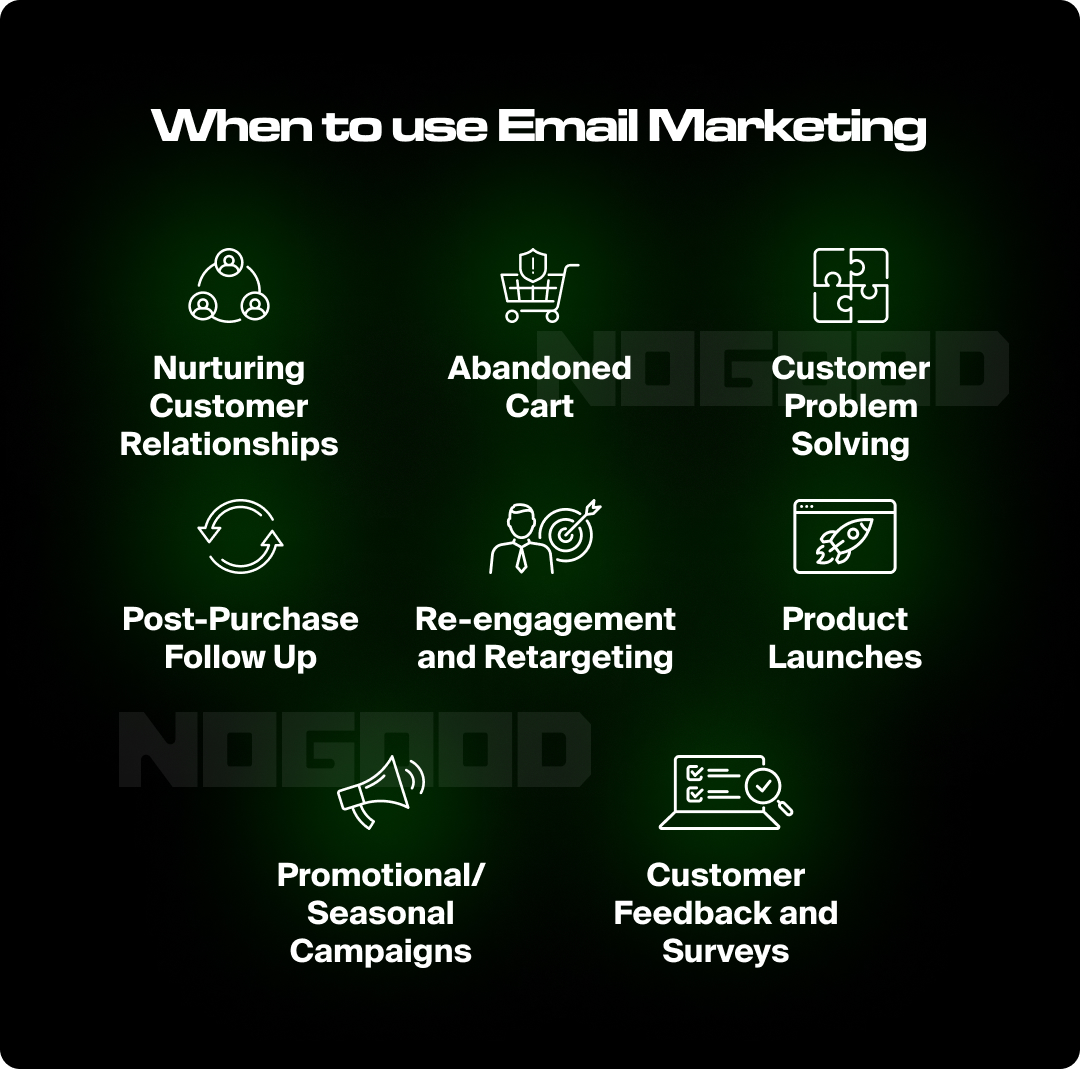SMS marketing and email marketing are lifecycle marketing channels that promote customer engagement and retention by optimizing each touchpoint of the customer journey.
Choosing between SMS and email marketing can make or break your customer engagement strategy. Recent data reveals a stark contrast: SMS marketing boasts an incredible 98% open rate and a 29% conversion rate, compared to email’s modest 20% open rate and 15.2% conversion rate. This isn’t just a numbers game — it’s about connecting with your audience in the most effective way possible.
SMS Marketing vs. Email Marketing: Which Is Better?
SMS marketing excels in immediacy, with most messages read within minutes. It’s ideal for time-sensitive campaigns like flash sales, appointment reminders, or urgent updates. On the other hand, email marketing is better suited for detailed communication, such as newsletters, product launches, or long-form content.
While SMS is more direct and personal, email offers greater flexibility in design and content depth. Ultimately, the most effective lifecycle marketing strategy often combines both channels — leveraging SMS for quick engagement and email for more comprehensive messaging.

When to Use SMS Marketing

So, when should you reach for SMS? Whenever you need to deliver concise, urgent messages that require immediate attention. It’s a powerful tool, perfect for cutting through the noise and reaching customers right where they are in real-time.
Time-Sensitive Promotions
SMS marketing is your go-to when you’re looking to get immediate attention for time-sensitive offers or alerts. Imagine sending out a flash sale notification that needs to be acted upon instantly — SMS is perfect for that. Its high open rates indicate that your message gets seen almost immediately.
Marketers can use attention-grabbing language like “Ends Tonight,” “Limited Time Offer,” or “Today Only” to instill FOMO and motivate customers to act quickly.
SMS messages can be optimized to be sent at just the right time to encourage a conversion. This can be when customers are winding down for the night or just getting off work. It can be helpful to run A/B testing to find which times result in the most conversions for your brand.
Order Confirmations and Shipping Updates
Order status updates are another great fit for SMS. Customers appreciate real-time notifications about their purchases, whether it’s a shipping confirmation or a delivery update. Keeping them in the loop builds trust and enhances their shopping experience.
Immediately acknowledge the purchase, confirming payment and order details. Proactive shipping notifications reduce customer anxiety, minimize support inquiries, and build trust. Customers appreciate transparent, direct communication about their purchases.
This first touchpoint sets the tone for customer communication. Notify customers when their product leaves the warehouse. Include tracking information and estimated delivery timeframe. Notifying the customer at each point of the shipping process promotes trust and increases the likelihood of repeat purchases.
Event Reminders
If an event is happening (like a sale or a webinar), SMS can be used to send last-minute reminders or updates, ensuring attendees are informed instantly. You can ask customers to click a link to shop your sale or confirm their seat at your event.
Customer Engagement
Creative campaigns like SMS scavenger hunts, quizzes, or contests encourage active participation. These activities not only entertain but also educate customers about the brand while fostering loyalty through rewards like discounts or points.
Brands can use SMS to tailor interactions by leveraging customer data. For instance, customers can personalize their preferences using keywords or receive product recommendations based on previous purchases, making the communication more relevant and engaging.
Ratings and Short Surveys
After a purchase or service interaction, businesses can send SMS surveys to gather immediate feedback on customer satisfaction. These surveys should be short and easy to complete, increasing response rates compared to email surveys.
SMS can also be used to request reviews or ratings shortly after a positive experience, such as resolving an issue via text-based support or completing a transaction. This ensures timely feedback while the experience is still fresh in the customer’s mind.
After resolving support inquiries via SMS, businesses can send follow-up surveys to evaluate the quality of their service. This helps identify areas for improvement and ensures customer concerns are addressed effectively. To boost participation in feedback campaigns, businesses can offer incentives like discounts or prize entries for completing surveys via SMS.
Personalized Offers and Loyalty Programs
Marketers can use SMS to engage customers post-purchase by offering upsells and promotions. By segmenting your audience, you can send personalized offers based on previous purchases or customer behavior, enhancing the relevance of the message and increasing engagement rates.
Brands can also use SMS to inform customers about loyalty points, rewards, or exclusive offers for members of their loyalty programs, encouraging repeat business.
Security
SMS is widely used for security purposes due to its ability to deliver time-sensitive and direct communications. Two-factor authentication (2FA) via SMS provides an extra layer of protection for online accounts. It’s a quick and effective way to verify identities and prevent unauthorized access.
SMS is also used to notify users of suspicious account activities, such as unauthorized login attempts or changes to account settings. These alerts allow users to take immediate action to secure their accounts. For eCommerce and banking, SMS one-time passwords are used to verify transactions, ensuring that only authorized users can complete payments or access sensitive information.
With many SMS scams circulating, marketers should be very clear and up front with customers about the type of communication they can expect when verifying and recovering their accounts.
When to Use Email Marketing

Email marketing is a powerful tool for building and maintaining strong, long-term relationships with customers. By delivering personalized, timely, and valuable content, businesses can engage their audience, foster loyalty, and encourage repeat interactions.
Nurturing Customer Relationships
Email is an effective tool for nurturing leads through a series of targeted communications that provide value, such as educational content, tips, and resources, helping to guide prospects down the sales funnel.
You can share tips, how-to guides, or industry insights that help customers get the most out of your products or services. This builds trust and positions your brand as a reliable resource. Email is your chance to add more depth to your customer communication and showcase what your brand has to offer.
Sending regular newsletters or updates keeps your brand top-of-mind for existing customers. This can include personalized offers, loyalty rewards, and product recommendations based on previous purchases.
Every email should include a clear CTA that encourages customers to take action — whether it’s exploring new products, completing a survey, or taking advantage of a special offer.
Customer Problem Solving
Email marketing can provide an opportunity to use customer pain points to showcase products or services as solutions.
Start by pinpointing the main issue your target audience faces. For example, if customers struggle with managing time, highlight this problem in the subject line and opening sentence of the email. This immediately grabs attention and makes the email relatable.
Show empathy by validating the customer’s struggles and showing that you understand their unique pain points. Email gives you the space to elaborate and connect with your audience, so really take the time to show you understand their problem.
After addressing the problem, introduce your product or service as the solution. Clearly explain how it alleviates the pain point and improves the customer’s situation. This creates a natural connection between their problem and your offering.
Email is particularly effective in addressing customer problems because it allows you to present the problem and solution to customers who may not be actively researching the problem at the time. By connecting with your customers through email, your brand can stay top-of-mind for when the customer is ready to address the problem.
Re-Engagement and Retargeting Campaigns
Emails are crafted to reconnect with subscribers by addressing their preferences or reminding them why they signed up. For example, businesses might highlight the original value they offered, such as exclusive content or discounts.
Re-engagement campaigns target subscribers who haven’t interacted with emails for a specific period. By segmenting these users, businesses can tailor their approach based on inactivity duration or past behaviors, making the outreach more relevant.
These campaigns focus on users who have shown interest in specific products or services but didn’t take action (e.g., abandoned carts or browsed items). Email segmentation ensures these customers receive personalized follow-ups based on their behavior.
For out-of-stock items that a customer previously viewed, retargeting emails notify them when the product becomes available again, driving conversions by reigniting interest. If a user browses products without adding them to their cart, retargeting emails can reintroduce those items with engaging visuals and CTAs like “Still thinking about this?”
Abandoned Cart Emails
Abandoned cart emails target potential customers who showed purchase intent but didn’t finalize their order. These emails boast high open rates (over 40%) and can recover up to 50% of abandoned carts when done strategically, making them essential for eCommerce businesses.
The first email is typically sent within 1–3 hours after the cart is abandoned. This reminds customers of their pending purchase while the items are still fresh in their minds, increasing the likelihood of conversion. If the customer does not act on the first email, a series of emails can be sent to encourage the customer to re-engage.
The abandoned cart email includes details like the customer’s name, images of the abandoned products, and specific product details like size or color. Personalization makes the email feel relevant and encourages the customer to continue looking at the products.
A prominent CTA button like “Complete Your Purchase” or “Return to Your Cart” is included to make it easy for customers to return to their cart and complete checkout. Including customer reviews or ratings for the abandoned products reassures customers of the product’s quality and value, helping them overcome hesitation.
Here’s what an abandoned cart email flow should look like:
- First Email (Reminder): Sent within a few hours to remind customers of their cart.
- Second Email (Incentive): Sent after 24–48 hours with a discount or special offer.
- Final Email (Urgency): Sent after 72 hours with language like “Items in your cart are running out!” to create urgency.
Post-Purchase Follow Ups
Sending a follow-up email immediately after a purchase shows appreciation and builds trust in your brand. These emails provide essential details about the purchase, including order summaries, shipping timelines, and tracking links. Keeping customers informed reduces anxiety and enhances trust in your brand.
Post-purchase emails can recommend complementary or upgraded products based on the customer’s previous purchase. For instance, if someone buys a camera, you could suggest lenses or accessories in follow-up emails. This strategy increases average order value while addressing customer needs.
These emails can also include how-to guides, product tutorials, or tips to help customers get the most out of their purchase. For example, the customer who purchased the camera would receive a tutorial for setting up the camera and ensuring proper lens use. You may also include a guide for cleaning and storing the camera.
Promotional Campaigns
Email marketing is ideal for announcing sales, discounts, or special promotions. It allows businesses to reach a large audience quickly with detailed information about the offer. With email marketing, you can easily capitalize on holidays and seasonal events.
Marketers can use customer segmentation data like past purchases or browsing behavior to send personalized promotional emails with tailored product recommendations.
Product Launches
When launching a new product or service, email can be used to generate excitement and provide detailed information about features, benefits, and availability.
You can build anticipation for new products by sending teaser emails that hint at the upcoming product. These emails might include sneak peeks, countdown timers, or invitations to join an exclusive waitlist. For example: “Something exciting is coming… Stay tuned!” This strategy creates anticipation and keeps your audience engaged.
After the initial launch email, send reminder emails to re-engage those who didn’t act. Use urgency tactics like “Last Chance to Save” or “Only a Few Left in Stock!” to drive conversions. Share customer reviews, influencer endorsements, or case studies in your emails to build trust and credibility. For example: “See why everyone’s talking about Product Name!”
Send follow-up emails that educate customers about the product’s features, benefits, and use cases. Include tutorials, FAQs, or comparison charts to demonstrate how your product solves their problems better than options from your competitors.
Keep momentum going with post-launch emails featuring additional resources like guides or webinars, cross-sell opportunities for related products, or invitations to share feedback.
Customer Feedback and Surveys
Marketers can use email to gather valuable feedback through surveys or polls, helping them understand customer preferences and improve products or services.
Sending feedback requests at strategic moments — such as immediately after a purchase or following a customer service interaction — ensures that the experience is fresh in the customer’s mind. This increases the likelihood of receiving thoughtful and relevant feedback.
It’s beneficial to personalize feedback emails by including the customer’s name, specific product details, or purchase history to make the communication feel more genuine. This approach encourages customers to engage with the email and share their thoughts, as they feel valued and recognized.
To make surveys more user friendly, you can embed questions directly into the email. For example, using a Net Promoter Score (NPS) question allows customers to respond with a single click, making it easy for them to provide feedback.
Creating an Omni-Channel Strategy with SMS and Email Marketing
Creating an omni-channel strategy that integrates SMS and email marketing allows businesses to deliver a seamless and cohesive customer experience. By leveraging the strengths of both channels, brands can engage customers at multiple touchpoints while ensuring consistency in messaging.
For instance, SMS can be used for time-sensitive updates, such as order confirmations or flash sales, while email provides a platform for more in-depth content, like newsletters or product recommendations. Synchronizing these channels ensures that customers receive timely and relevant communications without feeling overwhelmed.
Personalization plays a key role in this strategy — using customer data to tailor messages based on preferences, behaviors, and purchase history. When executed effectively, an omni-channel approach increases engagement, builds trust, and drives conversions by meeting customers where they are with the right message at the right time.





